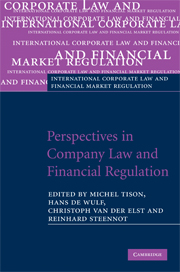Book contents
- Frontmatter
- Contents
- List of contributors
- Foreword
- PART I Perspectives in company law, SECTION 1: European company law: regulatory competition and free movement of companies
- PART 1 Perspectives in company law, SECTION 2: Corporate governance, shareholders' rights and auditing
- PART 1 Perspectives in company law, SECTION 3: Takeover law
- PART II Perspectives in financial regulation, SECTION 1: European perspectives
- PART 2 Perspectives in financial regulation, SECTION 2: Transatlantic perspectives
- 28 Learning from Eddy: a meditation upon organizational reform of financial supervision in Europe
- 29 The SEC embraces mutual recognition
- 30 Steps toward the Europeanization of US securities regulation, with thoughts on the evolution and design of a multinational securities regulator
- 31 The subprime crisis – does it ask for more regulation?
- 32 Juries and the political economy of legal origin
- PART III Miscellaneous
- Index
- References
29 - The SEC embraces mutual recognition
from PART 2 - Perspectives in financial regulation, SECTION 2: Transatlantic perspectives
Published online by Cambridge University Press: 04 August 2010
- Frontmatter
- Contents
- List of contributors
- Foreword
- PART I Perspectives in company law, SECTION 1: European company law: regulatory competition and free movement of companies
- PART 1 Perspectives in company law, SECTION 2: Corporate governance, shareholders' rights and auditing
- PART 1 Perspectives in company law, SECTION 3: Takeover law
- PART II Perspectives in financial regulation, SECTION 1: European perspectives
- PART 2 Perspectives in financial regulation, SECTION 2: Transatlantic perspectives
- 28 Learning from Eddy: a meditation upon organizational reform of financial supervision in Europe
- 29 The SEC embraces mutual recognition
- 30 Steps toward the Europeanization of US securities regulation, with thoughts on the evolution and design of a multinational securities regulator
- 31 The subprime crisis – does it ask for more regulation?
- 32 Juries and the political economy of legal origin
- PART III Miscellaneous
- Index
- References
Summary
Introduction
The traditional approach of the United States Securities and Exchange Commission (SEC) toward foreign (non-US) issuers, financial intermediaries and markets has been national treatment rather than mutual recognition. In the view of the SEC, mutual recognition was appropriate only when there was harmonized securities regulation between the US and a foreign jurisdiction. Accordingly, although the SEC made accommodations to foreign issuers, it rarely engaged in mutual recognition, the one important exception being the multi-jurisdictional disclosure (MJDS) regime with Canada. This exception actually proved the rule because the Canadians amended their securities laws to harmonize their securities regulations with US law, and to the extent that this was not the case, with regard to generally accepted accounting principles (GAAP), Canadian issuers were required to reconcile Canadian GAAP to US GAAP.
More recently, however, the SEC has been taking a new look at mutual recognition, and in the case of international financial reporting standards (IFRS) it now allows foreign issuers to use IFRS rather than US GAAP based on a theory of convergence rather than a requirement of harmonization. Furthermore, with regard to the prospect of foreign exchange and broker-dealer access to the US capital markets, the SEC is contemplating mutual recognition based on a theory of regulatory equivalence rather than a requirement of harmonization. On 1 February 2008, SEC Chairman Christopher Cox and European Union Commissioner for the Internal Market and Services Charlie McCreevy met in Washington, DC and agreed to a goal of an EU–US mutual recognition arrangement for securities regulation, declaring that ‘mutual recognition offers significant promise as a means of better protecting investors, fostering capital formation and maintaining fair, orderly, and efficient transatlantic securities markets’.
- Type
- Chapter
- Information
- Perspectives in Company Law and Financial Regulation , pp. 540 - 554Publisher: Cambridge University PressPrint publication year: 2009

